Related Research Articles
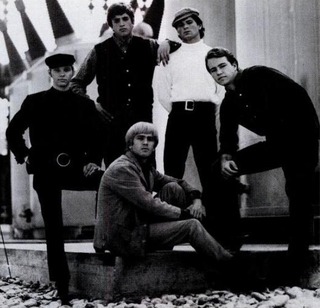
The Electric Prunes are an American psychedelic rock band, formed in Los Angeles, California, in 1965. Much of the band's music was, as music historian Richie Unterberger described it, possessed of "an eerie and sometimes anguished ambiance." Their most successful material was by songwriters Annette Tucker and Nancie Mantz, though the group also penned their own songs. Incorporating psychedelia and elements of embryonic electronic rock, the band's sound was marked by innovative recording techniques with fuzz-toned guitars and oscillating sound effects. In addition, guitarist Ken Williams' and singer James Lowe's concept of "free-form garage music" provided the band with a richer sonic palette and exploratory lyrical structure than many of their contemporaries.

The Shadows of Knight were an American rock band from Chicago, Illinois, that played a version of British blues influenced by their native city. When they began recording in 1965, the band's self-description was "the Stones, Animals and the Yardbirds took the Chicago blues and gave it an English interpretation. We've taken the English version of the Blues and re-added a Chicago touch," to which rock critic Richie Unterberger commented: "The Shadows of Knight's self-description was fairly accurate."

The Beau Brummels was an American rock band. Formed in San Francisco in 1964, the band's original lineup included Sal Valentino, Ron Elliott, Ron Meagher, Declan Mulligan, and John Petersen (drums). They were discovered by local disc jockeys who were looking to sign acts to their new label, Autumn Records, where Sylvester Stewart—later known as Sly Stone—produced the group's early recording sessions. Initially, the band's musical style blended beat music and folk music and typically drew comparisons to the Beatles, while their later work incorporated other music genres such as psychedelic rock and country rock.

"Dirty Water" is a song by the American rock band The Standells, written by their producer Ed Cobb. The song is a mock paean to the city of Boston, Massachusetts, and its then-famously polluted Boston Harbor and Charles River.

The Music Machine was an American rock band formed in Los Angeles, California in 1966. Fronted by chief songwriter and lead vocalist Sean Bonniwell, the band cultivated a characteristically dark and rebellious image reflected in an untamed musical approach. Sometimes it made use of distorted guitar lines and hallucinogenic organ parts, punctuated by Bonniwell's distinctively throaty vocals. Although they managed to attain national chart success only briefly with two singles, the Music Machine is today considered by many critics to be one of the groundbreaking acts of the 1960s. Their style is now recognized as a pioneering force in proto-punk; yet within a relatively short period of time, they began to employ more complex lyrical and instrumental arrangements that went beyond the typical garage band format.

Thomas Harvey "Sean" Bonniwell was an American singer-songwriter/guitarist, who was known as the creative force behind the 1960s garage rock band, The Music Machine.
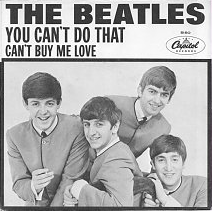
"You Can't Do That" is a song written by John Lennon and released by the English rock band the Beatles as the B-side of their sixth British single "Can't Buy Me Love". It was later released on their third UK album A Hard Day's Night (1964). A live rendition of the song was released on the 2016 re-release of The Beatles at the Hollywood Bowl.
"Chains" is a rhythm and blues song written by husband-and-wife songwriting team Gerry Goffin and Carole King. It was a hit for the American girl group the Cookies in 1962 and for the English rock band the Beatles, who recorded the song for their debut album in 1963. King recorded a solo version of "Chains" for her 1980 album Pearls: Songs of Goffin and King.

"I Put a Spell on You" is a 1956 song written and composed by Jalacy "Screamin' Jay" Hawkins, whose own recording of it was selected as one of the Rock and Roll Hall of Fame's 500 Songs that Shaped Rock and Roll. It was also included in Robert Christgau's "Basic Record Library" of 1950s and 1960s recordings—published in Christgau's Record Guide: Rock Albums of the Seventies (1981)—and ranked No. 313 on Rolling Stone magazine's list of The 500 Greatest Songs of All Time. The selection became a classic cult song covered by a variety of artists and was his greatest commercial success, reportedly surpassing a million copies in sales, even though it failed to make the Billboard pop or R&B charts.

"No Matter What" is a song originally recorded by Badfinger for their album No Dice in 1970, written and sung by Pete Ham and produced by Mal Evans.

"I'm a Man" is a song written by Steve Winwood and record producer Jimmy Miller. It was first recorded in 1967 by the Spencer Davis Group; Winwood sang lead vocals and played keyboards. The song was a hit in the United Kingdom and the United States, reaching No. 9 and No. 10, respectively. It has been recorded by many other performers over the years, most successfully by Chicago, whose version charted at No. 8 in the UK in 1970 and No. 49 in the US in 1971.
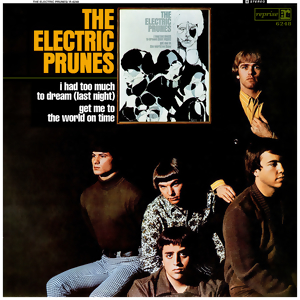
The Electric Prunes, sometimes referred to as I Had Too Much to Dream (Last Night), is the 1967 debut album by the American garage rock band, the Electric Prunes, released on Reprise Records. The first track, "I Had Too Much to Dream (Last Night)", was a hit and became the band's signature tune. The album also contains another notable psychedelic rock composition, "Get Me to the World on Time". The album was listed in the book 1001 Albums You Must Hear Before You Die.
The Rationals were an American rock band from Ann Arbor, Michigan.

"Darling Be Home Soon" is a song written by John Sebastian of the Lovin' Spoonful for the soundtrack of the 1966 Francis Ford Coppola film You're a Big Boy Now. It appeared on the Lovin' Spoonful's 1967 soundtrack album You're a Big Boy Now. Sebastian performed his composition at Woodstock; it was the fourth song out of the five he performed at the 1969 music festival in White Lake, New York.
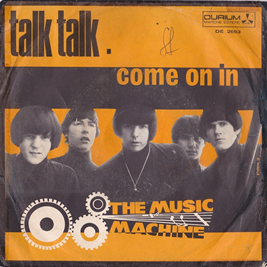
"Talk Talk" is the debut single of American garage rock band the Music Machine. It was released in November 1966, and produced the band's only Top 20 hit on the Billboard Hot 100. The song was included on their debut album, (Turn On) The Music Machine.
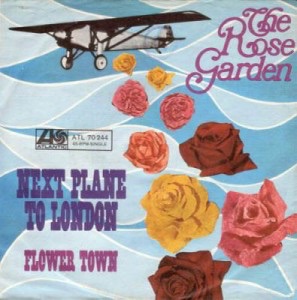
"Next Plane to London" is the debut single by the American folk rock band, The Rose Garden. The single, released by Atco Records, became the band's only Top 20 hit on the Billboard Hot 100 when it peaked at number 17. It would later reappear on the group's 1968 studio album, The Rose Garden. "Next Plane to London" made The Rose Garden one of the most memorable one-hit wonders of the late sixties, yet the song has never been recorded by another prominent group, apart from an unreleased demo by the band They Might Be Giants. A french language adaptation was recorded in 1968 by Quebec singer Renée Martel "Je vais à Londres".

Close is a solo album by American rock musician Sean Bonniwell, credited under the moniker T. S. Bonniwell, who had been the creative force behind the innovative garage rock band The Music Machine. The album was released on August 4, 1969, by Capitol Records. It marked a total departure from Bonniwell's rebellious protopunk period with The Music Machine, to a soft rock crooning style. In addition, the album blended folk rock and orchestrated influences, and was inspired by Bonniwell's stints in the pre-Music Machine groups, the Wayfarers and the Ragamuffins, along with his desire to be more poetically inclined. The song,"Where Am I to Go", was released as a single ahead of the album, but failed to chart. Like its attendant single, Close was also somewhat commercially unsuccessful, and was the last recording by Bonniwell for the next 20 years.

Ignition is a compilation album by the American garage rock band, The Music Machine, and was released on June 27, 2000 on Sundazed Records. It includes an assortment of rare singles, outtakes, and previously unreleased material spanning from when the group went under the moniker, the Raggamuffins, in 1965, to their disbandment in 1969. The Raggamuffins were a folk rock trio led by Sean Bonniwell, and the prototype group that developed an experimental hard-edge sound, before recruiting two additional members and becoming the Music Machine. By 1969, all the original members, except Bonniwell, departed the group, which was then known as the Bonniwell Music Machine. Though the band would no longer produce hits, such as "Talk Talk" and "The People In Me", it was Bonniwell's most ambitious recording period as he incorporated elements of psychedelia and pop rock into the group's music.

The Bonniwell Music Machine is the second and final album by the American garage rock band, The Music Machine, recorded under the renamed moniker, The Bonniwell Music Machine, and released on Warner Bros. Records, on February 10, 1968. As with their debut LP, the album again saw the band blending garage and psychedelic rock influences, albeit with a greater emphasis on psychedelia than on their previous album release. Prior to completing its recording, all of the group's original members, except for its creative force, Sean Bonniwell, departed, though they would still appear on some of the album's tracks.

(Turn On) The Music Machine is the debut studio album by the American garage rock band the Music Machine, released on Original Sound Records on December 31, 1966. It arrived just months after the group's hit single, "Talk Talk", propelled to number 15 on the national charts. Although the album was hastily recorded to capitalize on the Music Machine's popularity, (Turn On) The Music Machine managed to become a moderate hit on the Billboard Top LPs chart, and is hailed today as a classic garage rock album. Another single, "The People in Me" was also released in support of the album.
References
- ↑ Unterberger, Richie. "The People In Me – Song review". allmusic.com. Retrieved July 3, 2015.
- ↑ Fricke, David (4 January 2012). "The Dark Prince of Garage Rock: A Tribute to Sean Bonniwell of the Music Machine". rollingstone.com. Retrieved July 3, 2015.
- ↑ Unterberger, Richie (1998). Unknown Legends of Rock 'n' Roll . Miller Freeman. p. 61. ISBN 9780879305345 . Retrieved July 3, 2015.
the music machine the people in me.
- ↑ "RPM Top 100 Singles – April 18, 1967" (PDF).
- ↑ Whitburn, Joel (2013). Joel Whitburn's Top Pop Singles, 14th Edition: 1955–2012. Record Research. p. 598.